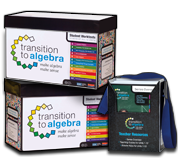
Students are often seen simply as consumers of word problems. A word problem is presented with all of the necessary information already embedded in it. The student must interpret the problem, extract the key numbers, and solve. (And repeat the same process with the next word problem).
A more effective way to develop true mathematical understanding is to present word problems as authentically as possible. When word problems are authentic, their structure is different. Students are no longer passive consumers—there is transaction and interaction. All of the key information is not planted into the scenario. Because of this, students engage the problem differently, asking questions, testing ideas, and organizing what they think they know. They become producers of a mathematical language, developing along the way a depth of understanding often missed with traditional approaches to instruction.
Watch Jane Kang, one of the coauthors of the Transition to Algebra program, talk about the power of tailless and headless word problems, how they are used in Transition to Algebra to develop foundational algebraic understanding, and how you can begin using them in your classroom today.
To see more videos of Jane talking about Transition to Algebra’s unique approach to algebra instruction, please visit TransitiontoAlgebra.com.
♦ ♦ ♦ ♦
 Transition to Algebra (TTA) grew out of an initiative of the Learning and Teaching Division at Education Development Center (EDC), an acclaimed curriculum development laboratory specializing in science and mathematics instruction. Building on EDC’s hands-on, inquiry-based approach to learning, TTA uses algebraic logic puzzles and explorations to help students shift their ways of thinking from the concrete procedures of arithmetic to the abstract reasoning that success with algebra requires. Learn more.
Transition to Algebra (TTA) grew out of an initiative of the Learning and Teaching Division at Education Development Center (EDC), an acclaimed curriculum development laboratory specializing in science and mathematics instruction. Building on EDC’s hands-on, inquiry-based approach to learning, TTA uses algebraic logic puzzles and explorations to help students shift their ways of thinking from the concrete procedures of arithmetic to the abstract reasoning that success with algebra requires. Learn more.




